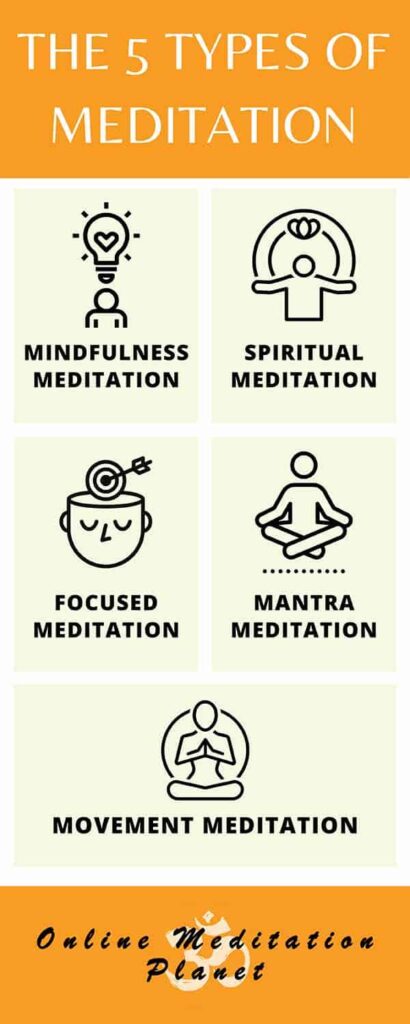In today’s world, you are more likely to find someone who is burned out than someone who is still excited about their lives, and it is no secret why. The monetized, machine-like state of our lives puts a lot of pressure on most employees to give more and go faster than is healthy, and most do. This has led to a deep need for today’s workers to find a way to relax without changing their situations. Luckily, there are at least five types of meditation available to offer peace and relaxation.
The five types of meditation are:
- Mindfulness
- Movement
- Progressive Relaxation
- Loving-Kindness
- Visualization
Meditation is a low-cost way to relax the mind and, by doing this, manage anxiety, depression, stress, and any problems these things cause. Read on to find out more about the five types of meditation.
What is Meditation?
Meditation is an exercise in which the meditator pays close attention to their mental state to encourage a more relaxed and peaceful one than they can normally reach in their day-to-day lives. There are many scientific benefits of meditation. This is combined with controlled movement, sound, and attention to create the many different versions of mediation available today.
Meditation has been around for a long time. Some historians believe the Neanderthals had a form of meditation, and the first written records of meditation crop up in India in 1500 BCE from the Hindu school of philosophy Vedantism.
In China, during the 3rd and 4th centuries BC, the Daoist, Laozi, wrote of meditation techniques still used today. It spread from China to Japan in the 7th century when Dosho, a Japanese monk, studied meditation under the master Hsuan Tsang. It reached the west in the 1700s with the translation of Eastern philosophy texts.
(Still questioning where does meditation come from? Check out that article for more on the topic!)
5 Types of Meditation

- Introspection: it’s essential to spend time alone with the meditator’s thoughts, but individuals who find that hard to do may use meditation to consider themselves without having a situation to force them to.
- Spirituality: Similar to introspection, spirituality-based meditation is meant to give time to the meditator with their own thoughts with the added goal of strengthening their bonds with their chosen deity or presence, regardless of the meditator’s specific religion.
- Stress control: stress is one of the great problems of the modern day. While some people are naturally good at approaching life in a way that reduces stress, others need to set aside a time and place where those stressors are not allowed to reduce their effect.
- Emotional control: much like stress control, emotional control is hard to come by without situations that provide experience, and meditation can do that without the high stakes other people can provide.
The following five types of meditation can help you achieve each of these goals.
Mindfulness Meditation
This is what most people think of when they hear the term meditation, and this type is aimed at introspection. Traditionally, mindfulness meditation is done by sitting still in a calm area and letting the meditator’s thoughts come and go as they please while always bringing the meditator’s attention back to the meditation process. The process is typically exemplified by something happening during the meditation, like breathing.
The meditator focuses on their breath instead of their thoughts, creating a space for thoughts to be had that does not allow them to have an emotional effect. This allows the meditator to consider those thoughts without having to control their emotions or look for a solution at the same time. Mindfulness mediation has three variations:
Spiritual
Spiritual mediation is focused on spirituality rather than mindfulness, but it works very similarly. The primary goal is to strengthen the bond between the meditator and their deity or belief system.
The meditator should still have the same safe space for their thoughts, but they should be viewed through the lens of their spirituality, leading to different conclusions and a stronger connection to the belief system.
Focused
Focused meditation is more for relaxation rather than introspection and is aimed at turning down the volume of the meditator’s internal monologue. This meditation requires the meditator to focus very intently on one thing, typically a sense like sight or touch.
Mindfulness mediation works for people who are not introspective enough. Focused mediation is for people who are too reflective.
Mantra
Mantra mediation is similar to focused mediation in that meditators use something to help their minds focus on the activity. In this case, the thing is a mantra, which translates to “mind release” in Sanskrit.
The meditator chooses a phrase or word to focus on; they may say this phrase aloud or mentally. The word or phrase used ties to the meditator’s overall goal in mediation. For instance, if you are meditating to reduce stress caused by the state of the world, the meditator’s mantra may be something like everything is going to be okay.
If the meditator’s mantra mediation is spoken aloud, it is typically considered transcendental meditation.
Movement Meditation
Movement meditation can be used for any of the four purposes. It recognizes that some meditators just cannot remain still and find peace, and it works by incorporating several types of movement, including cleaning, into the meditation. With movement mediation, which can be used for any of the four purposes, the meditator chooses an activity to do while meditating. They then concentrate on the mechanics of the movement the way a mindfulness meditator would concentrate on their breathing.
While many activities include slow movements such as yoga, any activity will work, although the meditator should use an activity that is easy for them or that they are already experienced in. It will be more difficult to meditate with an activity that you need to put the meditator’s full attention on.
Popular activities include yoga, walking, shaking, cleaning, and dancing, but whatever activity the meditator picks should not add on more stress, even if it is the stress of handling the meditator’s responsibilities.
Progressive Relaxation Meditation
Dr. Edmund Jacobson pioneered progressive relaxation in the early 1920s, and his book Progressive Relaxation was published in 1938. Initially, this form of meditation was used to treat anxiety. Later on, doctors found it effective for treating migraines, bipolar disorder, high blood pressure, insomnia, and more.
This type of meditation is aimed at stress control, and it works by addressing the physical tension the meditator carries in their body. The meditator either sits or lays down in a quiet, private space and tenses one of fifteen separate muscle groups for four to ten seconds. They then relax the group all at once and hold for ten to twenty seconds. At this point, the meditator can choose to repeat the process with the same muscle group, but to a lesser degree up to several times.
Finally, they move onto the next group and repeat the process. This is done in a specific order. When all the muscle groups have been tensed and relaxed, the meditator counts back from five to recenter themselves.
Loving-Kindness Meditation
This style of meditation is meant for emotional regulation, and a 2008 study found that seven weeks of loving-kindness meditation increased overall positive feelings. Loving-kindness meditation begins with the meditator finding a quiet space and beginning their chosen form of meditation. When the meditator is relaxed and in the right headspace, they imagine themselves as emotionally and physically at peace. This feeling of peace is the focus point.
Next, the meditator repeats a few positive, reassuring phrases such as I am happy for as long as they need to. Then, the meditator just exists in the positivity. At this point, the meditator can begin again, or they can shift their thoughts and emotions towards individuals in their life.
Loving-kindness meditation can be used for self-confidence, self-love, emotional maturity, and more. Studies also show that loving-kindness meditation is effective in coping with chronic pain, PTSD, schizophrenia-spectrum disorders, and migraines.
A version of loving-kindness, in which the meditator specifically focuses their thoughts on one person they know and love, is called skillful-compassion. This technique works especially well for meditators whose relationship(s) have gotten difficult, and the problems have begun to cloud their true feelings about a person.
Visualization Meditation
The last type of meditation is visualization, which works very similarly to loving-kindness. It takes advantage of the fact that your brain cannot always tell what is real and what is imagined and will have the same emotional response to either.
Instead of visualizing feeling at peace, though, the meditator should envision positive scenarios using as many senses as possible. These scenarios can, but do not have to, include the meditator or their loved ones. Once the scene is envisioned, the meditator should focus on the feelings they get from those scenes.
Visualization has two variations to it:
- Color breathing is a technique in which the meditator assigns an emotion that they want a color. When they inhale, they take in that color; when they exhale, they push out the complementary color. For instance, if the meditator wanted to feel love, they could assign love the color red. As they breathe in, they visualize their body becoming filled with red. As they exhale, their body empties of green.
- Goal visualization works the same way. Instead of the meditator envisioning an emotion they would like more of, they instead visualize a realistic goal that is large enough to feel special when reached but not so large that it cannot be reached in the near future or requires other people/divine intervention to happen. Athletes often use this technique to improve their game.
Overall, visualization meditation can improve performance, help with insomnia, and cope with depression.
Conclusion
There are many different variations on meditation, and each one is meant to address a specific need of the meditator, so it is okay if one or even most kinds of meditation do not work for you. At the end of the day, meditation is about seeing to your mental state, which has a significant effect on the rest of the body. So, note down which approaches might work for you, find a quiet place, and give it a shot. You can only get more peaceful from here.




